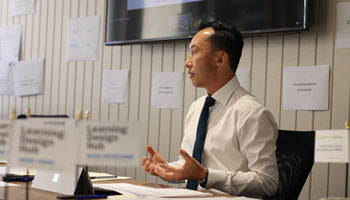AISNSW Online Learning has been supercharged to support the diverse needs of Independent school staff.
With the introduction of the AISNSW Learning Design Hub, online professional learning has taken a lead role in supporting member school educators and school staff to enhance and refine their skills.
In the first eight months of 2021, there has been an uptake in registrations of about 20,000 AISNSW self-paced professional learning opportunities, almost double the usual rate for this time of the year.

AISNSW Learning Design Hub Manager Stanley Yip.
No doubt the current lockdown restrictions have contributed to the increase, however AISNSW’s new approach to designing professional learning for teachers and school staff has been a key driver.
Understanding the diversity of the Independent school sector
Launched in 2020 out of a need to redefine professional learning, the Learning Design Hub’s dynamic team is made up of learning designers with backgrounds drawn from schools, TAFE, tertiary, adult learning, community colleagues, corporate and government.

The Learning Design Hub's purpose is to produce high-quality learning opportunities for AISNSW members.
“We respect that there are a lot of different types of Independent schools; that it’s a very diverse sector. We’re responsive to the evolving needs of teacher professional learning.”
Learning Design Hub Manager Stanley Yip says its purpose is “to share, nurture and grow learning design capabilities of AISNSW staff with the intent of creating high-quality learning opportunities for AISNSW members”.
The advantage of the Learning Design Hub over other learning providers is the team has a clear understanding of the unique qualities of the 400+ Independent schools in NSW, Stanley says.
“We respect that there are a lot of different types of Independent schools; that it’s a very diverse sector. We’re responsive to the evolving needs of teacher professional learning.”
Learning by design
Stanley and his team are passionate about adult learning and contemporary learning design principles. Their approach is to understand the needs of the adult Independent school learner and design opportunities based on learner profiles that meet each brief.
“We’ve shifted by starting with the learner rather than the learning because that will influence the content and activities offered,” he says.
“It’s about understanding the learner – that’s very important for us.”

The Learning Design Hub team works diligently to understand the needs of the adult learner.
“Empathy mapping is a way to really get into the mind and heart of the learner to find out how they feel, what they see, what they do in response to learning. We know that learning is not just cognitive, it’s social and emotional too.”
When creating a new course, the team draws on strategies and techniques that revolve around how a course participant or learner would best engage with the experience.
Conversations and collaboration take place with the content experts to understand the outcomes and the learner profiles are established to guide the design.
“The learner profiles are fictional but they are based on real characteristics so there is always a foundation for how we design. It starts with the learner, once we understand the learner the quality of professional learning flows,” Stanley says.
The focus on adult learning principles
Adult learning principles such as recognising prior learning, the importance of participant voice and input into the learning direction are incorporated so the experiences are targeted at adults.
“Adults need to have content that is relevant to them, job-ready and pragmatic,” Stanley says.
“Empathy mapping is a way to really get into the mind and heart of the learner to find out how they feel, what they see, what they do in response to learning.
“We know that learning is not just cognitive, it’s social and emotional too.”

The Learning Design Hub team understands the diversity of the Independent Schools.
This has meant factoring in platforms where participants can network and collaborate.
“We use collaborative platforms to ensure learners have a voice, can express their opinions and reflections, and build on each other’s ideas and insights,” Stanley says.
Growth in numbers of registrations and evaluation data show the remote learning is supporting AISNSW members across the state.
“We hope at the end of any AISNSW professional learning experiences that the participants feel challenged but refreshed and have new ideas and definitely new connections – that’s our hope at the end of our professional learning experiences – that they come away inspired and recharged.”
Remote learning used to be the second tier but now there are more opportunities for collaboration and for a sustained learning experience, Stanley adds. Digital learning also provides convenience and flexibility.
“They’re all pragmatic considerations. The other is the networking so metropolitan and regional schools can connect rather than being confined to a certain area or city, so it empowers the connecting nature of learning.
“We hope at the end of any AISNSW professional learning experiences that the participants feel challenged but refreshed and have new ideas and definitely new connections – that’s our hope at the end of our professional learning experiences – that they come away inspired and recharged.”
New to AISNSW and want to receive AISNSW Education News updates? Click here to register, and select ‘AISNSW Education News’ on the Areas of Interest/Subscriptions page.